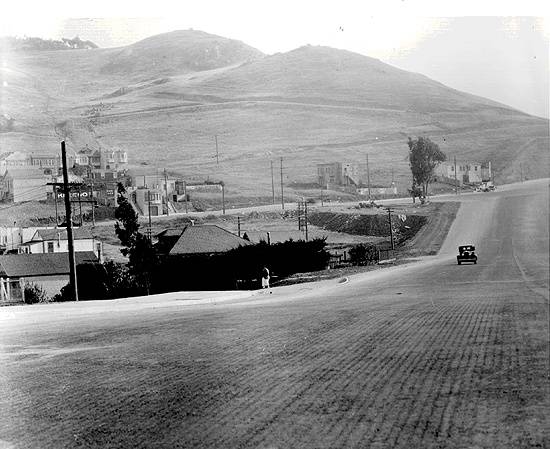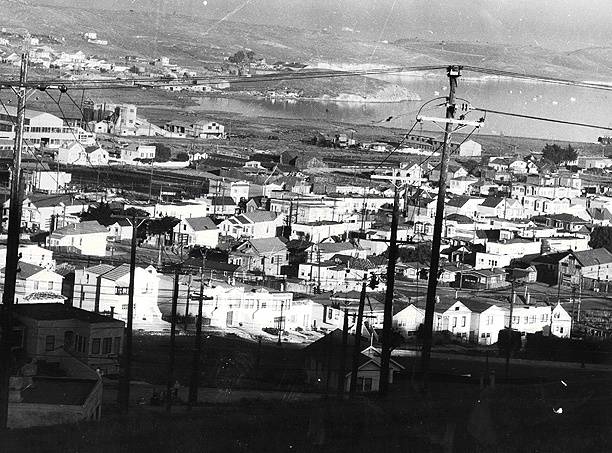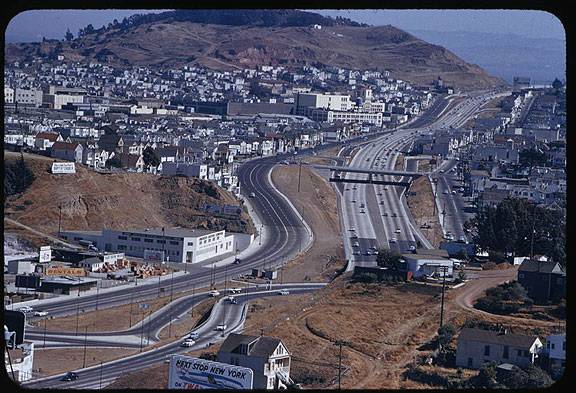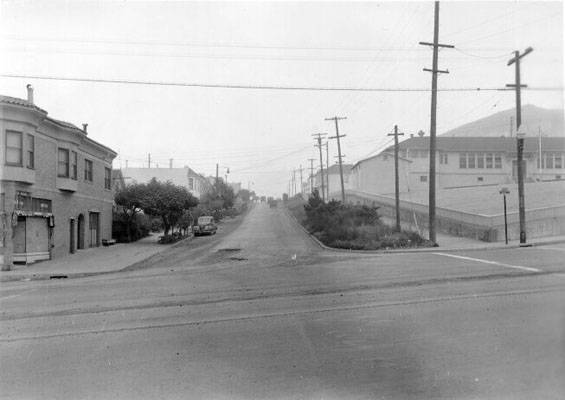Return of a Native to Bayview
"I was there..."
By Ruth Eshow Upton
"Black Mountain" loomed over the bucolic neighborhood described in this memoir, back in the 1920s when this photo was taken.
Photo: Gaar Collection, San Francisco, CA
In the mid-1970’s San Francisco newspapers frequently ran stories covering violence in the Bayview, a district described as a dangerous ghetto. These reports caught my attention because I grew up in the Bayview in the 1920’s and 1930’s when it was populated by home-owning immigrants from all over who enjoyed the pleasures of living in an area that combined a sense of country life with its grassy meadows, wild flower covered hills and a swimming beach as well as city amenities.
Yosemite creek where it meets the bay in 1928, when there was still small beaches along the shore of the Bayview district.
In 1939 following my widowed mother’s remarriage we moved to the Richmond district. I never returned to the Bayview. Most of my girlfriends had married and had settled elsewhere. When the Hunter's Point Shipyards were re-activated for the war, hordes of strangers poured into the city for newly-created jobs. Public housing went up in former empty lots covering hills where flowers and mushrooms used to grow. The newcomers spoke English with a funny accent to ears accustomed to the way it was spoken by our neighbors from Mexico, Europe, Asia and the Middle East. It was not the English taught by our public school teachers. An exodus of the old residents began, spurred by the commencement in the early l950’s of a freeway to supplant the old Bayshore Boulevard. Neighborhoods vanished, including our house on Le Conte Avenue. The final blow was the building of the ballpark, Candlestick Cove. The dairy that had once occupied Candlestick Point disappeared as well as most of the hill we called Black Mountain.
Old Bayshore Highway looking northward in 1929, not long after its construction.
Photo: San Francisco History Center, San Francisco Public Library
New Bayshore Freeway soon after opening, April 7, 1955. View from Bernal Heights southeast, with Bayview Hill in background.
Charles Cushman Collection: Indiana University Archives (P08309)
Many changes occurred in my life during the ensuing years. My marriage resulted in moves, in California, to Mexico and to Europe. Whenever my husband and I returned to California I went back to work in San Francisco where I maintained an apartment from which I commuted weekly to our home in Monterey. I sped over the grave of my childhood home, buried under the new freeway, hundreds of times without giving it much thought. But the news stores had aroused my curiosity so that one day in l975 I decided to drive to the Bayview and take a look.
Taking the San Bruno Avenue exit from l0l I found myself on a strangely familiar but different looking street. Everything looked gray, drab. I recognized the Giacomini house on the west side of San Bruno, not far from the Five Mile House. As a child I thought of it as an enchanted place. Built against the hill terraced gardens were filled with fruit trees, fragrant shrubs and flowers. Randomly placed among them were statutes and busts, some of animals, some of Roman emperors. I have a photo taken in that garden. I, aged four, scowl at one-year old Lily, who held up by my crouching mother, extends a flower to the camera., a flower she had picked without asking permission Now all I saw was a low concrete wall against which three young men lounged.
The lady of the house emerged. She eyed me suspiciously but relaxed when I explained my mission. She and her husband were immigrants from Yugoslavia I asked how things were going, She rolled her eyes and tilted her head towards the boys idling on the wall in a way that indicated uneasiness.
Jamestown Street at 3rd Street, 1943.
Photo: San Francisco History Center, SF Public Library
I went over to Third Street. Candlestick Park dominated what had been a neighborhood of small houses. Black Mountain which once loomed over the area between Third Street and the beach, where our parents picked mushrooms after the rains, was pathetic, emasculated. Gone was Bret Harte Grammar School and Miss McLaugherty’s school supply and candy shop.
I continued to Gilman Avenue. At the end of the block was a pleasant, if deserted, stretch of green lawn. As children we would turn left at this point and walk along the beach to the cove where everyone swam during the summer, on the beach side of Egbert Avenue. The gentle hill that rose between the cove and Egbert, once covered with grass, had served as a windbreak. Now it was covered with barracks-like public housing left over from the war years, most of them abandoned. The greatest shock however was that there was no beach! Instead of a stretch of golden sand I saw debris sticking up out of oily-looking water.
It made me sad. I thought of the reaction James Stewart showed as George Bailey in “It’s a Wonderful Life” when the angel shows him what his hometown would have been had he never lived. I reflected on how lucky I was that the Japanese ship, Siberia Maru, had deposited them at Angel Island in 1919, that they remained in San Francisco and settled in the Bayview in the era when it was a haven from immigrants with high hopes.
Preparations for entering the Second World War, building the freeway that uprooted whole neighborhoods and finally construction of the massive ballpark and its parking lot ended a way of life as different from today as were the horse and buggy years to us. For this reason I decided that a survivor of that place and that time should record how it was for curious future generations.





